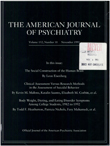Psychophysiologic assessment of traumatic imagery in Israeli civilian patients with posttraumatic stress disorder
Abstract
OBJECTIVE: This study used a script-driven imagery technique, previously used with combat veterans, to assess physiologic responses of Israeli survivors of noncombat traumas. METHOD: Each subject had experienced an event meeting DSM-III-R criterion A for posttraumatic stress disorder (PTSD). The subjects were classified on the basis of the full DSM-III-R criteria into a current PTSD group (N = 13) and a non-PTSD group (N = 13). Thirty-second scripts describing each subject's personal traumatic event, as well as other events, were prepared. The scripts incorporated subjective visceral and muscular responses reported to have accompanied each experience. In the laboratory, the scripts were read one at a time to the subject, who was instructed to imagine each event portrayed as vividly as possible, while heart rate, skin conductance, and left lateral frontalis electromyogram levels were measured. RESULTS: Multivariate analysis of variance revealed that the physiologic responses of the PTSD subjects during imagery of their personal traumatic experiences were significantly greater than those of the non-PTSD subjects. This difference was not explained by age, gender, or rated severity of the traumatic event. A physiologic discriminant function derived from previously studied Vietnam veterans correctly classified nine of the 13 PTSD subjects (sensitivity = 69%) and 10 of the 13 non-PTSD subjects (specificity = 77%). CONCLUSIONS: These results replicate previous findings of heightened physiologic responses during personal combat imagery in male American war veterans and extend them to a group of male and female Israeli civilian victims of trauma, supporting the robustness of physiologic responding during personal traumatic imagery as a measure of PTSD.
Access content
To read the fulltext, please use one of the options below to sign in or purchase access.- Personal login
- Institutional Login
- Sign in via OpenAthens
- Register for access
-
Please login/register if you wish to pair your device and check access availability.
Not a subscriber?
PsychiatryOnline subscription options offer access to the DSM-5 library, books, journals, CME, and patient resources. This all-in-one virtual library provides psychiatrists and mental health professionals with key resources for diagnosis, treatment, research, and professional development.
Need more help? PsychiatryOnline Customer Service may be reached by emailing [email protected] or by calling 800-368-5777 (in the U.S.) or 703-907-7322 (outside the U.S.).



